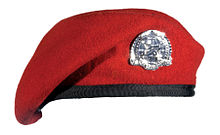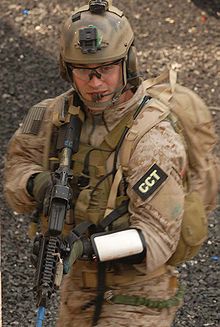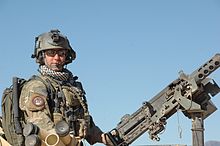- United States Air Force Combat Control Team
-
U.S. Air Force Combat Controller 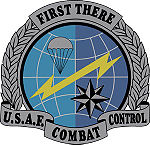
United States Air Force Combat Control Flash.Active January 1953 – present Country  United States of America
United States of AmericaBranch  United States Air Force
United States Air ForceType Special Operations Role Airfield Assault Zone Establishment, Special Reconnaissance, Air Traffic Control, Fire Support, Command, Control, and Communications Size 350[1] Part of Air Force Special Operations Command Motto "First there"  Air Force Combat Controllers participating in Operation Enduring Freedom provide air traffic control to a C-130 taking off from a remote airfield.
Air Force Combat Controllers participating in Operation Enduring Freedom provide air traffic control to a C-130 taking off from a remote airfield. Air Force Combat Controller Staff Sergeant Zachary J Rhyner on patrol with an Army Special Forces team in Afghanistan. SSgt Rhyner was awarded the Air Force Cross for his actions on 6 April 2008 in the Shok Valley of Afghanistan.
Air Force Combat Controller Staff Sergeant Zachary J Rhyner on patrol with an Army Special Forces team in Afghanistan. SSgt Rhyner was awarded the Air Force Cross for his actions on 6 April 2008 in the Shok Valley of Afghanistan.
United States Air Force Combat Controllers (CCT) (AFSC 1C2X1) are ground combat forces specialized in a traditional pathfinder role while having a heavy emphasis on simultaneous air traffic control, fire support and command, control, and communications in covert or austere environments. Assigned to Special Tactics Squadrons, Combat Controllers are an integral part of Air Force Special Operations Command (AFSOC), the Air Force component of United States Special Operations Command (USSOCOM). Combat Controllers are often assigned individually or as a team to Army Special Forces, Army Ranger, and Navy SEAL teams to provide expert air support coordination and communications capabilities.
Contents
Motto
CCT Motto: "First There," reaffirms the Combat Controller's commitment to undertaking the most dangerous missions behind enemy lines by leading the way for other forces to follow.
Mission
Air Force Special Operations Command's Combat Controllers are Battlefield Airmen assigned to special tactics squadrons. They are trained special operations forces and certified Federal Aviation Administration air traffic controllers. The mission of a Combat Controller is to deploy undetected into combat and hostile environments to conduct special reconnaissance, establish assault zones or airfields, while simultaneously conducting air traffic control, fire support, command, control, and communications and forward air control. They deploy with air and ground forces in support of direct action, such as drug cartel, counter-terrorism, foreign internal defense, humanitarian assistance, and combat search and rescue. Combat Controllers employ all-terrain vehicles, amphibious vehicles, weapons and demolitions in pursuit of their objectives, which may include obstacle destruction.
Training
Combat controllers are among the most highly trained personnel in the US military. They maintain air traffic controller qualification skills throughout their career in addition to other special operations skills. Many qualify and maintain currency in joint terminal attack control procedures. Their 35-week initial training and unique mission skills earn them the right to wear the scarlet beret. From that point they attend a 12-15 month advanced skill training course to obtain a 5 skill level.
Initial Training
- Combat Control Selection Course, Lackland Air Force Base, Texas (2 weeks)
This selection course focuses on sports physiology, nutrition, basic exercises, combat control history and fundamentals.[2]
- Combat Control Operator Course, Keesler Air Force Base, Mississippi (15.5 weeks)
This course teaches aircraft recognition and performance, air navigation aids, weather, airport traffic control, flight assistance service, communication procedures, conventional approach control, radar procedures and air traffic rules. All air traffic controllers in the Air Force attend this course.[2]
- Army Airborne School, Fort Benning, Georgia (3 weeks)
Trainees learn the basic parachuting skills required to infiltrate an objective area by static line airdrop.[2]
- Air Force Basic Survival School, Fairchild Air Force Base, Washington (3 weeks)
This course teaches techniques for survival in remote areas. Instruction includes principles, procedures, equipment and techniques that enable individuals to survive, regardless of climatic conditions or unfriendly environments, and return home.[2]
- Combat Control School, Pope Air Force Base, North Carolina (13 weeks)
This course provides final Combat Controller qualifications. Training includes physical training, small unit tactics, land navigation, communications, assault zones, demolitions, fire support and field operations including parachuting. Graduates of the course are awarded the 3-skill level (Apprentice), scarlet beret and CCT flash.[2]
Advanced Training
- Special Tactics Advanced Skills Training, Hurlburt Field, Florida (12 to 15 months)
Advanced Skills Training is a program for newly assigned Combat Controller operators. AST produces mission-ready operators for the Air Force and United States Special Operations Command. The AST schedule is broken down into four phases: water, ground, employment and full mission profile. The course tests the trainee's personal limits through demanding mental and physical training. Combat Controllers also attend the following schools during AST:
- Army Military Free Fall Parachutist School, Fort Bragg, North Carolina, and Yuma Proving Ground, Arizona (5 weeks)
This course instructs free fall parachuting procedures. The course provides wind tunnel training, in-air instruction focusing on student stability, aerial maneuvers, air sense, parachute opening procedures and parachute canopy control.[2]
- Air Force Combat Diver School, Navy Diving and Salvage Training Center, Naval Support Activity Panama City, Florida (6 weeks)
Trainees become combat divers, learning to use scuba and closed circuit diving equipment to covertly infiltrate denied areas. The course provides training to depths of 130 feet, stressing development of maximum underwater mobility under various operating conditions.[2]
History
United States Army pathfinders originated in 1943 out of need for accurate airdrops during airborne campaigns of World War II. These pathfinders preceded main assault forces into objective areas to provide weather information and visual guidance to inbound aircraft through the use of high-powered lights, flares and smoke pots.
When the Air Force became a separate service, Air Force pathfinders, later called combat control teams, were activated in 1953 to provide navigational aids and air traffic control for a growing Air Force. In the Vietnam War, combat controllers helped assure mission safety and expedited air traffic flow during countless airlifts. Combat controllers also flew as forward air guides in support of indigenous forces in Laos and Cambodia. It has been reported that Combat Controllers conducted covert forward air control for U.S. and allied aircraft performing interdiction missions against Communist troops and supplies on the Ho Chi Minh trail. Combat controllers were also present during the earthquakes in Haiti where they set up and coordinated airplanes to land and take off at airfields that had been heavily damaged in the quake.
See also
- Air Force Special Operations Weather Technician
- Combat Rescue Officer
- No. 2 Squadron RAF Regiment
- United States Air Force Pararescue
References
- ^ Seydel, Lieutenant Carie A. "Air Force Combat Controllers". About.com. http://usmilitary.about.com/od/airforce/l/blcct.htm. Retrieved 2008-06-11.
- ^ a b c d e f g "Combat Control Fact Sheet". Air Force Special Operations Command. United States Air Force. http://www2.afsoc.af.mil/library/factsheets/factsheet.asp?id=201. Retrieved 2008-11-24.
External links
- USAF Fact Sheet: Combat Control - 1C2X1
- Combat Control and STO
- CCT: The Eye of the Storm
- Combat Control School Association
Portal:Military of the United States United States Army
USASOCSpecial Forces · U.S. Army John F. Kennedy Special Warfare Center and School · 75th Ranger Regiment · 160th Special Operations Aviation Regiment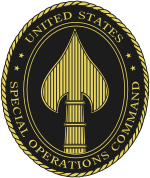
United States Marine Corps
MARSOCPart of SOCOM: Marine Special Operations RegimentUnited States Navy
NAVSPECWARCOMUnited States Air Force
AFSOCUnits: 1st Special Operations Wing · 27th Special Operations Wing · 352nd Special Operations Group · 353rd Special Operations Group
Types: Air Force Pararescue · Combat Control Team · Special Operations Weather · SERE · Tactical Air Control PartySpecial Mission Units
JSOCArmy: 1st SFOD - Delta (Delta Force) · Intelligence Support Activity
Navy: Naval Special Warfare Development Group (DEVGRU / SEAL Team Six)
Air Force: 24th Special Tactics Squadron
Other: Advanced Force Operations (AFO)Source: SOCOM Fact Book Categories:- United States Air Force
- United States Air Force careers
- United States Air Force Special Operations Command
Wikimedia Foundation. 2010.

